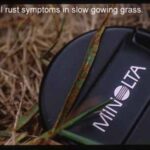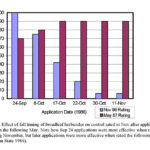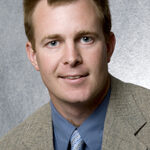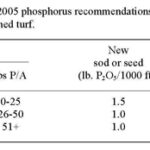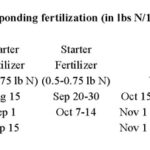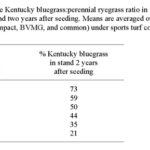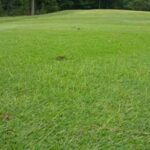Turf Tips Archives
Three Invasive White Grubs Found By Indiana Survey
The presence of three potentially serious white grub pests of turfgrass and ornamental plants were confirmed this year during surveys conducted by the Turfgrass Entomology and Applied Ecology Laboratory at Purdue University and the Indiana Cooperative Agricultural Pest Survey with the help of several golf course superintendents, concerned citizens and one very keen graduate student […]
Rust on the rise in turf
With the warm dry weather slowing growth of most turf areas, rust is becoming common on many non-irrigated turf areas. Rust symptoms are reddish-orange lesions or spots on the leaf blades and a rust-colored powder that you can rub off with your fingers. Rust will rarely kill a turf area further then a lawn already […]
Grub damage reports beginning to come in
Reports of grub damage are becoming more frequent this week. A number of reports of damage have come from northern IN where moisture conditions have created ideal conditions for grub damage in spite of preventative insecticide applications. If grub damage and live grubs are confirmed, insecticide applications are likely justified to limit future animal feeding […]
MRTF’s Turf and Ornamental Seminar in Nov 13-14
Mark your calendars for Nov 13-14 for MRTF’s Turf and Ornamental Seminar at the Daniel Center at Purdue. This course is an advanced for lawn care, golf course, sports turf, and sales staff. Enrollment is definitely limited to 70 attendees to optimize individual attention and allow plenty of time for questions and discussion. Topics this […]
How Late is Too Late to Control Dandelions and Other Weeds?
Even though the drought has limited some broadleaf weed applications this month, we are now in the prime season for broadleaf weed control. Actually there is plenty of time left for good control. Nebraska research reported in 2002 showed 2,4-D and/or dicamba were far more effective in controlling dandelions and Canada thistle when applied 1 […]
Renovating Turf: Just fertilize? Add seed? Start Over?
Now that cooler temperatures and at least a little rain is back, it’s critical to help turf recover. Though we’re out of the optimum seeding window in the northern 2/3rds of Indiana, most effective recovery will be through fertilizing with 0.75-1.0 lbs N/1000 every three to four weeks until the grass stops growing in early […]
MRTF Golf Day at Coyote Crossing on Oct. 11
Openings are still available for the MRTF Golf Day on Oct 11 at the Hale Irwin-designed Coyote Crossing Golf Club in West Lafayette. This annual event is held to promote turfgrass research, raise awareness of the Purdue Turfgrass Science Program, and provide an enjoyable day of golf. It’s an early morning event starting at 8:30 […]
Dr. Aaron Patton Receives 2007 Musser Award
The Musser International Turfgrass Foundation has selected Dr. Aaron J. Patton of the University of Arkansas as the recipient of the 2007 Musser Award of Excellence. The award, which carries a stipend of $20,000, was presented earlier this year at the Golf Industry Show in Anaheim, Calif. Patton, 29, now serves as an assistant professor […]
Renovating Turf: How long should I wait to seed after a glyphosate (Roundup) application?
I have received a number of email questioning the wait for seeding after glyphosate applications. Glyphosate has no soil activity and will therefore not affect seedlings when seeded even the same day of application. However, for maximum control of tough-to-control weeds with stolons or rhizomes, a 7 day delay is recommended before raking or aerification […]
Fertilization: Do it right and protect the environment
Though much research over the years has shown that when fertilizer is applied properly to turf, it does not leach or runoff. The key to this is proper application as careless applications can cause problems. Following is a quick list of precautions when applying fertilizer (or pesticides) to your lawn. ·Apply the right rate and […]
September is Crucial for Fertilizing All Cool-Season Turfs
With the returning rains in the state, now is the most important time to fertilize cool-season turfgrasses like creeping bentgrass, Kentucky bluegrass, perennial ryegrass, and tall or fine fescue. September fertilization is crucial on all turf areas regardless if it is a lawn, athletic field, or golf course green, tee or fairway. Fertilization in mid-September […]
Precipitation Deficit Map as of 15 August
Though many parts of central IN was lucky enough to get significant rainfall this week, many parts of the state have not. Below is the Rainfall Deficit Map as of Aug 15, courtesy of the Indiana State Climate Office. This information and much weather information is available at www.iclimate.org
Gray Leaf Spot Update
We have just documented the first case of gray leaf spot this year from a golf course in Bloomington . We have learned that the disease will develop over a broad range of environmental conditions (not just hot and wet) and it continues to be very dry south of Indianapolis . Our research results showed […]
Rejuvenating Turf Areas After Drought
Eight weeks or more of high temperatures with minimal rain has taken a toll on turfgrasses around the state. Though some local areas in central IN have received ample rain in the last week, many areas are still very dry. We are just entering the window when significant turf recovery can be encouraged. Reseeding is […]
How much perennial ryegrass Kentucky bluegrass in a mix?
With the renovation season fast-approaching, questions abound about how much perennial ryegrass to use in a P. rye/K. bluegrass mix. Perennial ryegrass germinates quickly and provides quick cover and soil stabilization when used in a blend. However, too much perennial ryegrass leads to long-term problems from dollar spot, brown patch, red thread, and other diseases. […]
Something New in Golf Course Turf…Ghost Grass and Mad Tiller Disease???
Photo by: Steve McDonald of Turfgrass Disease Solutions located in Philadelphia Photo by: Cale Bigelow in West Lafayette Over the past week a relatively new turf malady has become prevalent on golf turf throughout the region. This new phenomenon has been referred to as “Mad Tiller Disease”, and “Ghost Grass” in the United Kingdom , […]
Turf Field Day Held July 17
Thank you to everyone who attended and helped make the 2007 Midwest Regional Turf Field Day a success on Tuesday, July 17. Though we had rain for the first time in at least 19 years that dramatically affected the day, this years registration easily topped 700. Attendees had the opportunity to view the latest in […]
Preemergence herbicides starting to break in hot spots
Crabgrass is starting to breakthrough in hotspots next to walks and drives, southern exposures, and in thin turf. Though many are quick to question the effectiveness of the specific preemergence herbicide used last spring, the vast majority of the breakthrough is due to weather, environment, or application techniques. Our research plots this year are showing […]
Nematode Survey Still On-Going
As summer stresses start to take a toll on our cool-season grasses on greens, more questions are arising about the potential of nematodes. We found ring and stunt nematodes in many of our samples from last year, but we’re not convinced yet that they are a primary cause in turf decline (see http://www.agry.purdue.edu/turf/tips/2006/nem112.htm for complete results). Pinpointing […]
Now is the Time to Start Improving Your Lawn
Tired of the way your lawn looks? If it hasn’t looked up to par this summer reseeding your lawn is an option. Mid-August is the best time to seed a new lawn or overseed an existing lawn, but planning should start now. If the lawn is just thin and needs a little help, fall is […]
